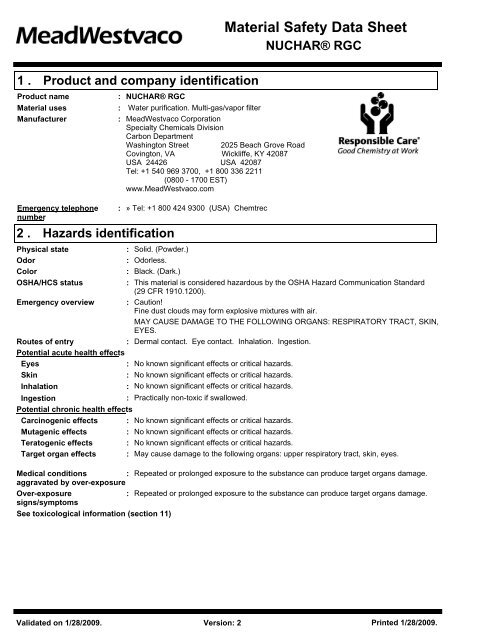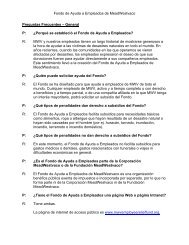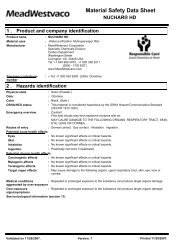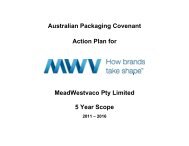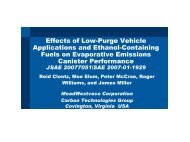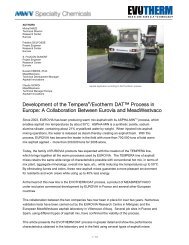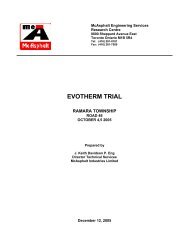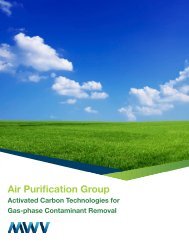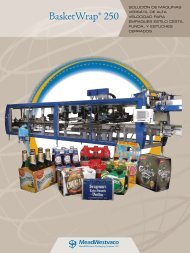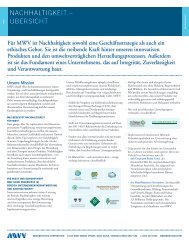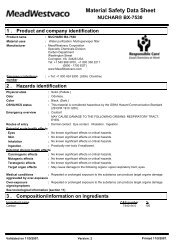NUCHAR® RGC - MeadWestvaco
NUCHAR® RGC - MeadWestvaco
NUCHAR® RGC - MeadWestvaco
You also want an ePaper? Increase the reach of your titles
YUMPU automatically turns print PDFs into web optimized ePapers that Google loves.
1 .<br />
Product name<br />
Material uses<br />
Manufacturer<br />
Product and company identification<br />
Emergency telephone<br />
number<br />
2 .<br />
Hazards identification<br />
: <strong>NUCHAR®</strong> <strong>RGC</strong><br />
: Water purification. Multi-gas/vapor filter<br />
: <strong>MeadWestvaco</strong> Corporation<br />
Specialty Chemicals Division<br />
Carbon Department<br />
Washington Street 2025 Beach Grove Road<br />
Covington, VA Wickliffe, KY 42087<br />
USA 24426 USA 42087<br />
Tel: +1 540 969 3700, +1 800 336 2211<br />
(0800 - 1700 EST)<br />
www.<strong>MeadWestvaco</strong>.com<br />
:<br />
» Tel: +1 800 424 9300 (USA) Chemtrec<br />
Material Safety Data Sheet<br />
<strong>NUCHAR®</strong> <strong>RGC</strong><br />
Physical state : Solid. (Powder.)<br />
Odor : Odorless.<br />
Color : Black. (Dark.)<br />
OSHA/HCS status : This material is considered hazardous by the OSHA Hazard Communication Standard<br />
(29 CFR 1910.1200).<br />
Emergency overview : Caution!<br />
Fine dust clouds may form explosive mixtures with air.<br />
MAY CAUSE DAMAGE TO THE FOLLOWING ORGANS: RESPIRATORY TRACT, SKIN,<br />
EYES.<br />
Routes of entry<br />
Potential acute health effects<br />
: Dermal contact. Eye contact. Inhalation. Ingestion.<br />
Eyes<br />
: No known significant effects or critical hazards.<br />
Skin<br />
: No known significant effects or critical hazards.<br />
Inhalation<br />
: No known significant effects or critical hazards.<br />
Ingestion<br />
: Practically non-toxic if swallowed.<br />
Potential chronic health effects<br />
Carcinogenic effects : No known significant effects or critical hazards.<br />
Mutagenic effects : No known significant effects or critical hazards.<br />
Teratogenic effects : No known significant effects or critical hazards.<br />
Target organ effects : May cause damage to the following organs: upper respiratory tract, skin, eyes.<br />
Medical conditions<br />
aggravated by over-exposure<br />
: Repeated or prolonged exposure to the substance can produce target organs damage.<br />
Over-exposure<br />
signs/symptoms<br />
: Repeated or prolonged exposure to the substance can produce target organs damage.<br />
See toxicological information (section 11)<br />
Validated on 1/28/2009.<br />
Version: 2 Printed 1/28/2009.
3 .<br />
<strong>NUCHAR®</strong> <strong>RGC</strong><br />
Composition/information on ingredients<br />
Page: 2/6<br />
Ingredient name CAS number % by weight<br />
Carbon 7440-44-0 100<br />
4 .<br />
First aid measures<br />
Eye contact<br />
: Immediately flush eyes with plenty of water for at least 15 minutes, occasionally lifting<br />
the upper and lower eyelids. Check for and remove any contact lenses. Get medical<br />
attention if irritation occurs.<br />
Skin contact<br />
: Flush contaminated skin with plenty of water. Remove contaminated clothing and<br />
shoes. Get medical attention if irritation occurs. Wash clothing before reuse.<br />
Inhalation<br />
: Get medical attention if irritation occurs. Move exposed person to fresh air. If not<br />
breathing, if breathing is irregular or if respiratory arrest occurs, provide artificial<br />
respiration or oxygen by trained personnel. It may be dangerous to the person providing<br />
aid to give mouth-to-mouth resuscitation. If unconscious, place in recovery position and<br />
get medical attention immediately. Maintain an open airway. Loosen tight clothing such<br />
as a collar, tie, belt or waistband.<br />
Ingestion<br />
: Wash out mouth with water. Remove dentures if any. If material has been swallowed<br />
and the exposed person is conscious, give small quantities of water to drink. Stop if the<br />
exposed person feels sick as vomiting may be dangerous. Do not induce vomiting<br />
unless directed to do so by medical personnel. If vomiting occurs, the head should be<br />
kept low so that vomit does not enter the lungs. Get medical attention if irritation occurs.<br />
Never give anything by mouth to an unconscious person. If unconscious, place in<br />
recovery position and get medical attention immediately. Maintain an open airway.<br />
Loosen tight clothing such as a collar, tie, belt or waistband.<br />
Protection of first-aiders : No action shall be taken involving any personal risk or without suitable training.<br />
5 .<br />
Fire fighting measures<br />
Products of combustion<br />
Extinguishing media<br />
: Emits acrid smoke and irritating fumes when heated to decomposition.These products<br />
are carbon oxides (CO, CO2).<br />
Suitable : Use an extinguishing agent suitable for the surrounding fire.<br />
Not suitable : None known.<br />
Special exposure hazards : None.<br />
Explosive properties : No specific hazard.<br />
Special protective equipment : Fire-fighters should wear appropriate protective equipment and self-contained breathing<br />
for fire-fighters<br />
apparatus (SCBA) with a full face-piece operated in positive pressure mode.<br />
Special remarks on fire<br />
hazards<br />
: None.<br />
Special remarks on explosion:<br />
Explosibility: Class St1 (Kst = 105 bar m/s)<br />
hazards<br />
Fine dust clouds may form explosive mixtures with air.<br />
6 .<br />
Accidental release measures<br />
Personal precautions : Immediately contact emergency personnel. Keep unnecessary personnel away. Use<br />
suitable protective equipment.<br />
Environmental precautions : Avoid dispersal of spilled material and runoff and contact with soil, waterways, drains<br />
and sewers.<br />
Methods for cleaning up : If emergency personnel are unavailable, vacuum or carefully scoop up spilled material<br />
and place in an appropriate container for disposal by incineration. Avoid creating dusty<br />
conditions and prevent wind dispersal.<br />
Validated on 1/28/2009.<br />
Version: 2 Printed 1/28/2009.
7 .<br />
Handling<br />
Storage<br />
8 .<br />
Handling and storage<br />
:<br />
:<br />
<strong>NUCHAR®</strong> <strong>RGC</strong><br />
Wash thoroughly after handling.<br />
Keep container tightly closed. Keep container in a cool, well-ventilated area.<br />
Exposure controls/personal protection<br />
Personal protection<br />
Eye/face<br />
Skin :<br />
:<br />
Page: 3/6<br />
Particulates (Not otherwise regulated) OSHA PEL<br />
TWA: 15 mg/m<br />
Engineering measures : No special ventilation requirements. Good general ventilation should be sufficient to<br />
control airborne levels. If this product contains ingredients with exposure limits, use<br />
process enclosures, local exhaust ventilation or other engineering controls to keep<br />
worker exposure below any recommended or statutory limits.<br />
3 (Total particulates)<br />
TWA: 5 mg/m3 (Respirable Particulate)<br />
ACGIH TLV<br />
TWA: 10 mg/m3 (Inhalable particulates not otherwise specified)<br />
TWA: 3 mg/m3 (Respirable particulates not otherwise specified)<br />
Safety eyewear complying with an approved standard should be used when a risk<br />
assessment indicates this is necessary to avoid exposure to liquid splashes, mists, gases<br />
or dusts.<br />
Recommended: safety glasses with side-shields ; Possible: splash goggles , face shield<br />
Chemical-resistant, impervious gloves complying with an approved standard should be<br />
worn at all times when handling chemical products if a risk assessment indicates this is<br />
necessary.<br />
>8 hour/hours (breakthrough time): disposable vinyl<br />
Respiratory<br />
:<br />
Personal protective equipment for the body should be selected based on the task being<br />
performed and the risks involved and should be approved by a specialist before handling<br />
this product.<br />
Body: Recommended: disposable overall<br />
Use a properly fitted, particulate filter respirator complying with an approved standard if<br />
a risk assessment indicates this is necessary. Respirator selection must be based on<br />
known or anticipated exposure levels, the hazards of the product and the safe working<br />
limits of the selected respirator.<br />
Recommended: If dust is generated and ventilation is inadequate, use respirator that will<br />
protect against dust/mist.<br />
Other protection : Keep away from heat and ignition sources. Store in a cool, well-ventilated place.<br />
Hygiene measures : Wash hands, forearms and face thoroughly after handling. Appropriate techniques<br />
should be used to remove potentially contaminated clothing. Wash contaminated<br />
clothing before reusing. Ensure that eyewash stations and safety showers are close to<br />
the workstation location.<br />
9 .<br />
Physical and chemical properties<br />
General information<br />
Physical state : Solid. (Powder.)<br />
Color : Black. (Dark.)<br />
Odor<br />
: Odorless.<br />
Important health, safety and environmental information<br />
Density : 0.32 g/cm<br />
Specific gravity<br />
Other information<br />
: The only known value is 1.5 (Water = 1) (Carbon).<br />
Decomposition temperature : Not available.<br />
Auto-ignition temperature : 420 to 450°C (788 to 842°F)<br />
3 (2.656 lb(s)/gal)<br />
Validated on 1/28/2009.<br />
Version: 2 Printed 1/28/2009.
10 .<br />
Stability and reactivity<br />
<strong>NUCHAR®</strong> <strong>RGC</strong><br />
Page: 4/6<br />
Stability<br />
: The product is stable.<br />
Incompatibility with various<br />
substances<br />
: Reactive or incompatible with the following materials: oxidizing materials.<br />
Hazardous polymerization : Will not occur.<br />
Conditions of reactivity : Flammable in the presence of the following materials or conditions: open flames, sparks<br />
and static discharge and heat.<br />
Explosibility: Class St1 (Kst = 105 bar m/s)<br />
Fine dust clouds may form explosive mixtures with air.<br />
11 .<br />
Toxicological information<br />
Toxicity data<br />
Product/ingredient name Test Result Route Species<br />
Carbon LD50 >5000 mg/kg Oral Rat<br />
Target organ effects : May cause damage to the following organs: upper respiratory tract, skin, eyes.<br />
Specific effects<br />
Carcinogenic effects : No known significant effects or critical hazards.<br />
Mutagenic effects : No known significant effects or critical hazards.<br />
Teratogenicity /<br />
Reproductive toxicity<br />
Irritant/Sensitizer<br />
: No known significant effects or critical hazards.<br />
Ingestion : No known significant effects or critical hazards.<br />
Inhalation : No known significant effects or critical hazards.<br />
Eyes : No known significant effects or critical hazards.<br />
Skin : No known significant effects or critical hazards.<br />
12 .<br />
Ecological information<br />
Environmental precautions : No known significant effects or critical hazards.<br />
Products of degradation : Most inorganic compounds are not biodegradable.<br />
Toxicity of the products of<br />
biodegradation<br />
: The product itself and its products of degradation are not toxic.<br />
13 .<br />
Disposal considerations<br />
Waste disposal<br />
: The generation of waste should be avoided or minimized wherever possible. Avoid<br />
dispersal of spilled material and runoff and contact with soil, waterways, drains and<br />
sewers. Disposal of this product, solutions and any by-products should at all times<br />
comply with the requirements of environmental protection and waste disposal legislation<br />
and any regional local authority requirements.<br />
Disposal should be in accordance with applicable regional, national and local laws and regulations. Local regulations<br />
may be more stringent than regional or national requirements.<br />
The information presented below only applies to the material as supplied. The identification based on characteristic(s)<br />
or listing may not apply if the material has been used or otherwise contaminated. It is the responsibility of the waste<br />
generator to determine the toxicity and physical properties of the material generated to determine the proper waste<br />
identification and disposal methods in compliance with applicable regulations.<br />
Refer to Section 7: HANDLING AND STORAGE and Section 8: EXPOSURE CONTROLS/PERSONAL PROTECTION for<br />
additional handling information and protection of employees.<br />
Validated on 1/28/2009.<br />
Version: 2 Printed 1/28/2009.
14 .<br />
Regulatory<br />
information<br />
Transport information<br />
DOT Classification<br />
(Bulk)<br />
IATA-DGR Class<br />
UN number Proper shipping<br />
name<br />
Not<br />
regulated.<br />
Not<br />
regulated.<br />
<strong>NUCHAR®</strong> <strong>RGC</strong><br />
- -<br />
-<br />
IMDG Class Not<br />
regulated.<br />
- -<br />
PG* : Packing group<br />
15 .<br />
Regulatory information<br />
Page: 5/6<br />
Class PG* Label Additional information<br />
-<br />
Remarks<br />
Nuchar Activated<br />
Carbon is not<br />
considered<br />
spontaneously<br />
combustible under the<br />
"Self-Heating Test for<br />
Carbon" protocol listed<br />
in the United Nations<br />
Manual of Tests and<br />
Criteria [33.3.1]. As<br />
such, Class 4.2<br />
provisions for U.S.<br />
DOT, IATA, ICAO,<br />
ADR and IMDG<br />
shipments do not<br />
apply.<br />
HCS Classification : Target organ effects<br />
U.S. Federal regulations : TSCA: No products were found.<br />
SARA 302/304/311/312 extremely hazardous substances: Not applicable.<br />
SARA 302/304 emergency planning and notification: Not applicable.<br />
SARA 302/304/311/312 hazardous chemicals: Not applicable.<br />
SARA 311/312:<br />
Carbon: Immediate (acute) health hazard<br />
State regulations<br />
: No products were found.<br />
California Prop. 65<br />
Canada<br />
International regulations<br />
: The required chemical analyses and risk assessments were performed on this product.<br />
Results indicate that there are no significant risks (or observable effects), as defined by<br />
this statute, associated with this product under conditions of normal use.<br />
Not controlled under WHMIS (Canada).<br />
Canadian NPRI: No products were found.<br />
International lists : United States: This product and/or its components are TSCA Listed.<br />
Validated on 1/28/2009.<br />
Canada: This product and/or its components is DSL Listed or acceptable under CEPA<br />
registration regulations.<br />
Europe: This product is EINECS listed.<br />
Australia: This product is AICS listed.<br />
Japan: This product contains ENCS and MITI listed components.<br />
China: This product is listed on the Chinese IECSC.<br />
Version: 2 Printed 1/28/2009.<br />
-<br />
-
15 .<br />
16 .<br />
Regulatory information<br />
Other information<br />
<strong>NUCHAR®</strong> <strong>RGC</strong><br />
South Korea: This product is ECL Listed.<br />
Philippines: This product is PICCS Listed.<br />
Switzerland: Acceptable.<br />
HMIS : Health 1 * NFPA : Health<br />
Fire hazard 1<br />
Flammability<br />
Reactivity 0<br />
Instability<br />
Personal protection C<br />
Special<br />
Date of issue<br />
: 1/28/2009.<br />
Date of previous issue : No previous validation.<br />
Prepared by : <strong>MeadWestvaco</strong> Corporation - Product Stewardship Group<br />
Email: jcp9@<strong>MeadWestvaco</strong>.com<br />
Tel: +1 843 746 8276<br />
1<br />
1<br />
0<br />
Page: 6/6<br />
Notice to reader<br />
To the best of our knowledge, the information contained herein is accurate. However, neither the above-named<br />
supplier, nor any of its subsidiaries, assumes any liability whatsoever for the accuracy or completeness of the<br />
information contained herein.<br />
NO WARRANTIES OF USE OR OTHERWISE ARE EXPRESSLY MADE OR IMPLIED FROM THIS INFORMATION. Final<br />
determination of suitability of any material is the sole responsibility of the user. All materials may present unknown<br />
hazards and should be used with caution. Although certain hazards are described herein, we cannot guarantee that<br />
these are the only hazards that exist.<br />
The following are registered trademarks (®) of <strong>MeadWestvaco</strong> Corporation:<br />
AIR PLAS, AQUA NUCHAR, AQUAGUARD, ARMOREZ, ELASTOREZ, HYACT, IMPACT, INDULIN, JONREZ,<br />
KRAFTPLEX, KRAFTSPERSE, LIQRENE, LIQRO, MAXCOTE, MEADWESTVACO, MORTAR PLAS, NUCHAR, OPAS,<br />
POLYFON, RALUMAC, REAX, STAFOR, TALLEX, TENAX, TRUDOT, WESTREZ, WESTVACO DIACID<br />
The following are trademarks (TM) of <strong>MeadWestvaco</strong> Corporation:<br />
BIO-NUCHAR, CELLULOSE SOLUTIONS, EMULGATOR, HYATOP, LASERSAFE, MORLIFE, OLEOCHEM, PAVE,<br />
PAVEBOND, PERAL, POLYCHEM, POLYFAC, STAFLEX, SURETROPE, SURFSHIELD, SYNPAQUE, ULTRA PLAS,<br />
WECOTE<br />
NA<br />
English (US)/ENGLISH.<br />
Validated on 1/28/2009.<br />
Version: 2 Printed 1/28/2009.


